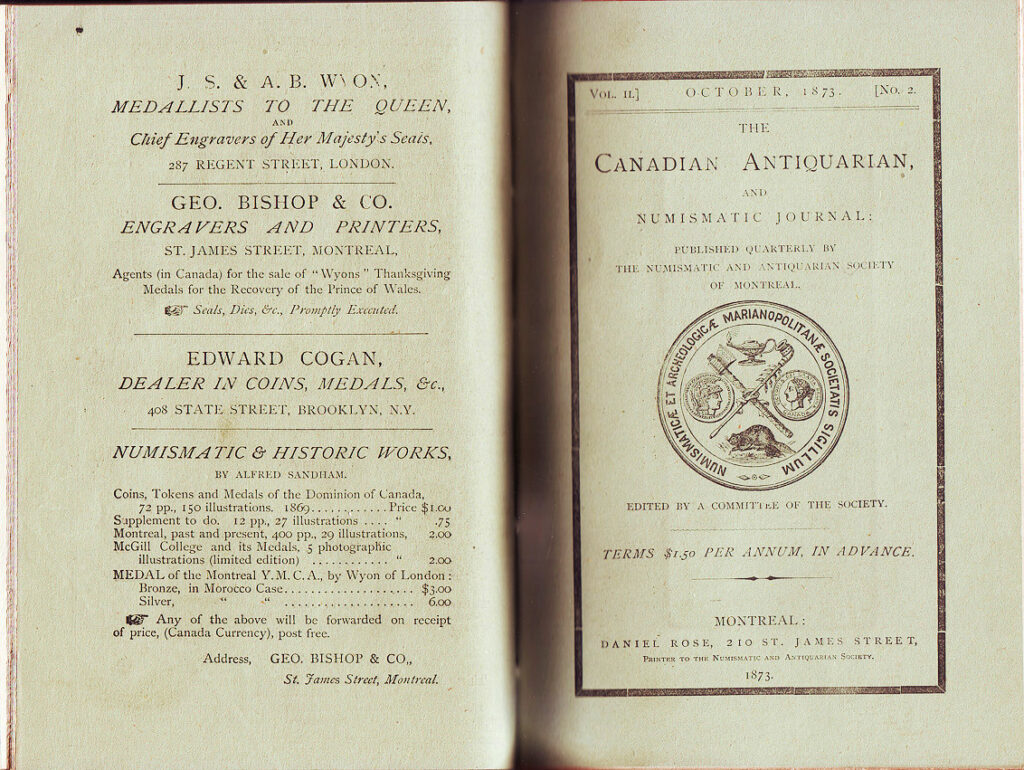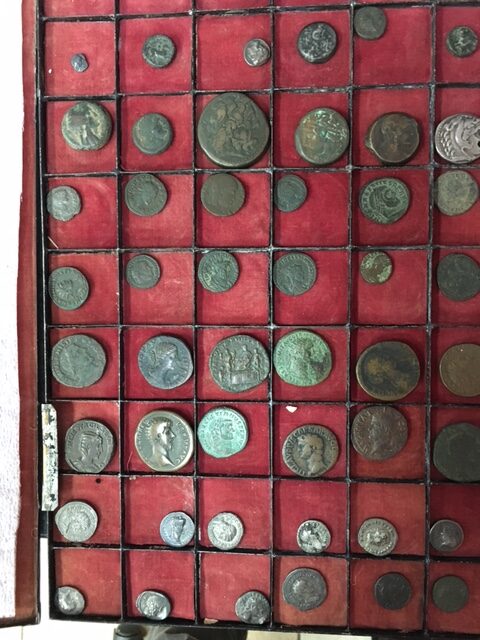This is the last in a series of articles about Stanley Clark Bagg’s life. In the future, I will write about the properties he owned in Montreal, and how they have been developed and become part of the city’s heritage. See below for links to other stories in the series.
After Stanley Clark Bagg (1820-1873) and his family returned home to Montreal from a year-long trip through Europe in 1868-1869, he wrote a small book about some of the places they had visited. Published in 1870, he called it Continental Notes for Private Circulation.1 The irony is that, 150 years after this book appeared, it is far from private: it can be found in university libraries, and it is also available on the Internet.
Continental Notes highlights 20 of the places the Bagg family visited, including Paris, Venice, Strasbourg, the Rhine River, Waterloo, the ruins of Pompeii and the French Riviera.
I was excited to find a copy of this little book on an open circulation shelf at McGill University a few years ago. I had read a lot about my great-great-grandfather, but I hoped to get to know him a little better by reading his own words.
At first glance, the book seemed dry and impersonal. This was disappointing, considering that SCB and his wife, Catharine, had made the trip with his sister-in-law and five children, ranging in age from seven to 20. The trip was no doubt considered an essential part of the children’s education. Surely there must have been some surprises or amusing incidents along the way that he could have described. But SCB explained in the introduction that the book was based on his personal notes, some of which were written before they even left Montreal. And this was a man of the Victorian era who had a reputation for being conservative, at least in politics. As a member of Montreal’s elite, his writing style was no doubt appropriately reserved.2
On closer reading, however, it became clear that Continental Notes reflected his personal interests, which included history (especially the Roman Empire and the early history of Christianity) and archaeology.

In the two pages he wrote about Paris, he gave more space to the Hôtel de Cluny, which he called “one of the finest remains of the ancient mansions of Paris of the 16thCentury,” than he did to the Louvre. He added that the Palais des Thermes, once the residence of the Roman Governor of Gaul, was connected to Hôtel de Cluny and housed a collection of antiquities that was open to the public. That museum of medieval art is still there, so when my husband and I visited Paris in 2010, we visited it. One of the treasures it houses today is a famous series of tapestries,The Lady and the Unicorn.
One of the other spots SCB included in his book was Hyères, a town located near the Mediterranean coast of France, between Nice and Marseilles. It had been a winter resort for centuries, with French kings among its regular visitors. SCB mentioned its warm winter climate, which may have been one of its attractions for him, and went on to write, “The environs of Hyères abound in vineyards and olive gardens.… This reminds me of the good Samaritan who poured oil and wine into the wounds of the man that fell among thieves. Who can walk through these pleasant vineyards without thinking of our blessed Lord when he said, ’I am the true vine, and my Father the husbandman.’”
Forty years ago, long before I knew anything about Stanley Clark Bagg, I spent a month in Hyères, taking classes at a French language school there. Hyères was not the area’s most attractive town and, as I read his book, I wondered what he would have found of interest there. Then it occurred to me that, besides the weather, he was probably interested in its ruined medieval castle. SCB noted, “The ruined walls and towers of the Castle of Hyères stand on a hill above the town. It is probable that this Roman fortress dates as far back as the sixth century.” I did walk up to the ruins one afternoon, but was not as excited about the castle as he was.

Many years later, I came across some notes that probably referred to that trip. Someone had put them in the Bagg family Bible, perhaps so they wouldn’t get lost.3 The notes reveal that the family not only visited France, Belgium, Prussia, Switzerland, Italy and the Papal States, but also Ireland, Scotland and England.
These little reminders probably reveal as much of SCB’s attitude on the road as his book does, and most of them remain good advice 150 years later:
Do not fill trunks, nor take too many. Look after luggage.
Read up references, prepare routine, currency, etc.
Letter of introduction useful.
“A soft answer turneth wrath away.” Keep cool, be firm, good-tempered, “polite.”
Staterooms on ships near stairs, seat at table near Captain.
Do not leave bills, business until last minute.
Be at boat or cars at least 15 min. early.
Never give up passports.
“Fee” the steward, etc. when you go on board — more attentive.
Take what clothing you may require for voyage in a carpet bag — trunk may be too large for admission to staterooms.
Seasickness: Norton’s chamomile pills. 10[?] drops in brandy, mixed with water. Adults, children in proportion.
Deposit office for articles in all [railway] stations in Eng. Ire. Scotland. A penny or two.
Check given, office responsible for loss. Great convenience.
This article is also published on Genealogy Ensemble (http://genealogyensemble.com)
Sources:
- Stanley Clark Bagg, Continental Notes for Private Circulation, Montreal, printed by Daniel Rose, 1870. https://www.canadiana.ca/view/oocihm.02377/1?r=0&s=1 (accessed April 8, 2020)
- SCB’s most personal writing is probably his poetry. The title, Leisure Moments, seems something of a misnomer, however, given that this small collection of poems he had printed in 1871 features melancholic themes such as grief for deceased loved ones and assurances of a beautiful afterlife. Leisure moments [electronic resource] : a few poems, by Stella [i.e. Stanley Clark Bagg], Bagg, S. Clark. Montreal, 1871 https://catalog.hathitrust.org/Record/100248153 (accessed Jan. 5, 2020.)
- I found these notes in the family Bible at the McCord Museum, Montreal, and copied them then, but when I looked again a few years later, they were no longer there.
See also:
Stanley Clark Bagg’s Coin Collection, March 19, 2020, https://www.writinguptheancestors.ca/2020/03/stanley-clark-baggs-coin-collection.html
Stanley Clark Bagg’s Family, Feb. 28, 2020, https://www.writinguptheancestors.ca/2020/02/stanley-clark-baggs-family.html
A Trip to England in 1842, Feb. 7, 2020, https://www.writinguptheancestors.ca/2020/02/a-trip-to-england-in-1842.html
Stanley Clark Bagg and the Custom of Paris, Jan. 21, 2020, https://www.writinguptheancestors.ca/2020/01/stanley-clark-bagg-and-custom-of-paris.html
Stanley Clark Bagg’s Early Years, Jan. 8, 2020, https://www.writinguptheancestors.ca/2020/01/stanley-clark-baggs-early-years.html
Fairmount Villa, Dec. 18, 2019, https://www.writinguptheancestors.ca/2019/12/fairmount-villa.html


